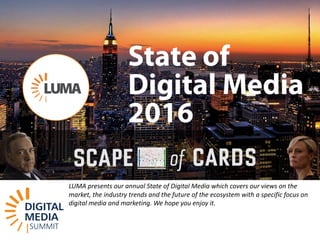
LUMA's State of Digital Media at DMS 16
- 2. Meet the Senior LUMA Team Terry Kawaja Brian Andersen Mark Greenbaum Dick Filippini Gayle Meyers Founder and CEO Partner Partner Partner CMO Terry leads strategy, banking and content for LUMA. He’s also head comedy writer and performer. Brian is LUMA’s marketing technology guru. He excels at coaching both little league and big clients. Mark runs M&A strategy and execution for LUMA. He’s never met a term sheet he couldn’t improve. Dick leads LUMA’s mobile and gaming banking coverage. You can find him holding court every February in Barcelona. Gayle runs LUMA’s marketing, events, and partnerships. She may be new, but she’s already formidable.
- 29. Venture capital investment had seen steady increases from 2013, peaking the third quarter of 2015.
- 33. We have seen M&A activity from all sectors, Media, Marketing, Technology, and Network / Commerce.
- 48. Fortunately, we’ve seen an evolution to better formats as smart companies have focused on improving the mobile ad experience. Chartboost was one of these innovators when they introduced interstitials that had a native look and feel - note the wrapper around the ad creative that matches the publisher’s art. Companies like Celtra, Facebook and Snapchat have focused on how consumers use their phones for specific use cases and have developed best practices for presenting video ads in feeds.
- 53. Advertisers are experimenting with messaging platforms to connect with consumers in new, engaging ways. This can be as simple as Swyft Media offering a Minions-themed keyboard, a powerful branding opportunity. Inmoji is making emojis interactive, so users can share brand experiences with a clickable Starbucks emoji that leads to an offer or gift. Snapchat Lenses like the Gatorade sponsored Lens during the Super Bowl saw 160 million views that day, with average engagement time north of 30 seconds.
- 87. The industry is taking notice as evidenced by Rovi’s recent acquisition of Tivo and it won’t stop there. We expect strategics to make major moves before the dust settles.
